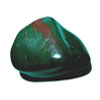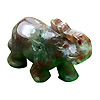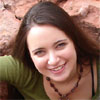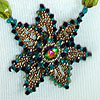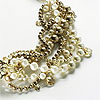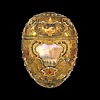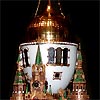March, 2009

Happy blossom time!How can you not love spring - birds singing, flowers blooming, the rest of snow finally melting? Do you have any fun plans for a break? Not yet? So, read MyLovelyBeads.com newsletter!
Bloodstone - heliotrope
Contact us with any questions at
info@mylovelybeads.com.
Mentioned in Washington Post Featured artist - Scarlett Lanson Faberge Easter eggs Artwork by Victoria Katamashvili Step by step - Easter Souvenirs April upcoming events Best regards,
MyLovelyBeads.com Team |
Bloodstone - heliotropeBloodstone is the original birthstone for March. Today, bloodstone, jasper and aquamarine are all considered the gemstones for March. The mineral bloodstone, also known as heliotrope, is a form of chalcedony. The "classic" bloodstone is green chalcedony with red inclusions of iron oxide or red jasper. Sometimes the inclusions are yellow, in which case the mineral is given the name plasma. It also occurs in shades of dark green with red, brown and multicolored spots. The red inclusions are supposed to resemble spots of blood; hence the name "bloodstone". The name "heliotrope" (from Greek HELIOS - Sun, and TREPEIN - to turn) derives from various ancient notions about the manner in which the mineral reflects light. Perhaps the appearance of the gem reminded the ancients of the red setting sun, mirrored in the ocean. The primary source of the stone is India. It is also found in Brazil, China, Australia, Kathiawar Peninsula in India, Germany, Scotland, Czech Republic, Russia and the United States (Wyoming). In ancient times bloodstone was thought to have the ability to stop hemorrhages by merely touching the stone. Ancient warriors often carried a bloodstone amulet which was intended to stop the bleeding when applied to a wound. Engraved bloodstone was used by the Babylonians in divination, and both they and the ancient Egyptians used it to magically defeat enemies, usually by employing the stone's abilities to increase personal strength and yet make its wearer "invisible" when they wanted attention focused strategically elsewhere. The Leyden Papyrus declared that "The world has no greater thing than bloodstone," it opens all doors for its owner, breaks down the walls of prisons and averts many disasters. In the Middle Ages the red spots were thought to be the blood of Jesus, according to a legend, it was first formed when drops of Christ's blood fell and stained some jasper at the foot of the cross. Boccaccio writes about making one "invisible" in his Decameron. Medieval Christians often used bloodstone to carve scenes of the crucifixion and martyrs, and in sculptures representing flagellation and martyrdom, leading it to also be dubbed "martyr's stone". |
|
Mentioned in Washington PostRaw Materials, Talent in Old Town Alexandria - this article in The Washington Post (Friday, March 20, 2009; Page WE05) is not about Zoya Gutina. Holly E. Thomas' story is on the Torpedo Factory Art Center in Alexandria, VA, "home to more than 160 artists tucked away in 82 studios, as well as five cooperative galleries, two workshops dedicated to printmaking and fiber arts, and an art school where adults and children can channel their inner Picasso." And at the end of the article talking about maze-like top level of the factory, Holly advises to "visit jewelry designer Zoya Gutina, whose intricate, hand-beaded necklaces are nothing short of stunning." Thank you, Holly! |
|
Featured artist - Scarlett LansonHave you ever heard about Scarlett Lanson? Not yet? There is no wonder, that young jewelry designer from Sedona, Arizona, is only 18 years old! And we are sure, she has a great future! Scarlett says, "I first came on to the bead-scene when I won the International Swarovski Crystal "CREATE YOUR STYLE" Design Competition 2007, in February 2008. This was my very first contest attempt, and I placed "Fourth in the World" / Amateur Division. I was seventeen at the time, and competing against many seasoned adult designers. ...My mother introduced me to beads at age three. We would make little dragonflies and flowers with seed beads and wire. I taught myself the varying beading techniques, and made up many of my own. I passionately studied beading magazines and experimented creating new stitches. I dreamt of someday working with one of these magazines. Today, I am a contributing editor to Interweave Press' BEADWORK magazine, with my own department, called "Scarlett's Style." I also participate often in their Beadwork Challenge and contributor's Q & A sections. ...My labor of love is my "Use the Muse" beading design contest, that I produce. As I have so enjoyed participating in contests and the BEADWORK Challenge, I have created this contest series to share my zest for beading. The contest will be going international, in the future. The first one was open to US residents, and exceeded all our expectations! We invited beaders of all levels of expertise and specialties to purchase the online components kit, and email photos of their submissions. 60+ beaders did so, and the results were vast and extraordinary. It was the first contest experience for many. ...I find much of my inspiration comes from nature and brand new materials. My mother and I recently attended the Tucson Gem and Mineral Show for our second time. I am really blessed to have it in my home state. It is amazing to peruse the seemingly endless sea of gem and bead laden tables and racks. My favorite finds were semi-precious polished cabochons. ...As for my beading future, I am working on my book proposal. I have a lot of exploration to undertake. Ultimately, I aspire to have a bead store and I'm often working on my business plan towards that goal. I am most passionate about designing and staying connected to the vibrant beading community. It is those interactions that make this life's path so meaningful!"
Gallery on MyLovelyBeads.com
|
|
Faberge Easter eggsThe egg was a symbol of the rebirth of the earth in Pagan celebrations of spring and was adopted by early Christians as a symbol of the rebirth. The egg is widely used as a symbol of the start of new life, just as new life emerges from an egg when the chick hatches out. The ancient Persians painted eggs for Nowrooz, their New Year celebration, which falls on the Spring equinox. At the Jewish Passover Seder, a hard-boiled egg dipped in salt water symbolizes the Passover sacrifice offered at the Temple in Jerusalem. The pre-Christian Saxons had a spring goddess called Eostre, whose feast was held on the Vernal Equinox, around 21 March. Her animal was the spring hare. Some believe that Eostre was associated with eggs and hares, and the rebirth of the land in spring was symbolized by the egg. Easter eggs are specially decorated eggs given to celebrate the Easter holiday or springtime. For Orthodox Christians, the Easter egg is much more than a celebration of the ending of the fast, it is a declaration of the Resurrection of Jesus. Traditionally, Orthodox Easter eggs are dyed red to represent the blood of Christ, shed on the Cross, and the hard shell of the egg symbolized the sealed Tomb of Christ - the cracking of which symbolized his resurrection from the dead. Easter eggs are a widely popular symbol of new life in Russia, Romania, Poland and other Slavic countries' folk traditions. A batik (wax resist) process is used to create intricate, brilliantly-colored eggs; there are any other decorating techniques and numerous traditions of giving them as a token of friendship, love or good wishes. The celebrated Faberge workshops created exquisite jeweled Easter eggs for the Russian Imperial Court. Carl Faberge and his goldsmiths designed and constructed the first egg in 1885. It was commissioned by Czar Alexander III of Russia as an Easter surprise for his wife Maria Fyodorovna. On the outside it looked like a simple egg of white enameled gold, but it opened up to reveal a golden yolk. The yolk itself had a golden hen inside it, which in turn had a tiny crown with a ruby hanging inside, reminiscent of the matryoshka nesting dolls. Empress Maria was so delighted by this gift that Alexander appointed Faberge a "Court Supplier" and commissioned an Easter gift each year thereafter, stipulating only that it be unique and contain a surprise. His son, Nicholas II of Russia continued the tradition, annually presenting an egg each spring to his wife Alexandra Fyodorovna as well as his then-widowed mother. Sixty nine jeweled eggs were made by Peter Carl Faberge and his assistants between 1885 and 1917, they were produced almost every year. Once an initial design was approved, the work was carried out by an entire team of artisans under Peter Carl Faberge, among them Michael Perkhin, Henrik Wigstrom and Erik August Kollin. The eggs are made of precious metals or hard stones decorated with combinations of enamel and gem stones. Most of these creations themselves contained hidden surprises such as clock-work birds, or miniature ships. The term "Faberge egg" has become a synonym of luxury and the eggs are regarded as masterpieces of the jeweler's art. They are not edible. |
|
Bead artwork by Victoria Katamashvili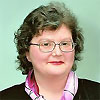
Another artist we want to feature today is Victoria Katamashvili. Born in Moscow, raised in Soviet Georgia, since the age of 13 she has lived in Gorky (now Nizhny Novgorod). Victoria graduated from the State University and has worked as a computer programmer. When the youngest Victoria's daughter started beading, Victoria also decided to try, it was in 2000. She says, since then beading is her passion and she spend all her spare time designing and creating beaded items of any kind. Victoria doesn't have any preferences in style or technique. As she says, she is always learning and feels comfortable using any media: beads, wire, gemstones, crystals. Mostly she makes beaded jewelry, but recently in collaboration with fashion designers she started working on incorporating bead embroidery into fashion clothes. Victoria is a winner of many jewelry design contests and a veteran exhibitor, she also contributes her tutorials and articles to bead magazines. We think, you will like and enjoy the pieces of beadart by Victoria Katamashvili, as we did!
Gallery on MyLovelyBeads.com
|
|
Step by step - Easter Souvenirs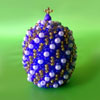
As we mentioned above, there are many decorating techniques and folk traditions to create a symbol of new life - Easter eggs. One of the most popular is beading around plastic or wooden eggs. As celebration, beadweavers include various themes on her eggs such as churches, birds, animals, and crosses. Victoria Katamashvili can teach you how to make the easiest beaded Easter eggs. She says, that it is not as hard as it seems to be and even a beginner can do that. The same technique can be used for creating some other souvenirs like small beaded toys. If you want to learn, try! Since you have any questions, don't hesitate, ask Victoria, you may reach her at master-raduga@yandex.ru, and she will be glad to help you!
How to make Easter Souvenirs
|
|
April upcoming events
April 23-26, 2009 Show - The annual Smithsonian Craft Show is a juried exhibition and sale of contemporary American crafts. Three jurors who are experts in the field and newly selected each year choose 120 artists from a large pool of applicants. |
|
NoteIf you don't see the newsletter properly formatted please click here: March Issue |
© 2010 MyLovelyBeads.com All Rights Reserved.
If you do not want receive our newsletter and you wish to remove your email address from our mailing list, please click the following link to unsubscribe.



